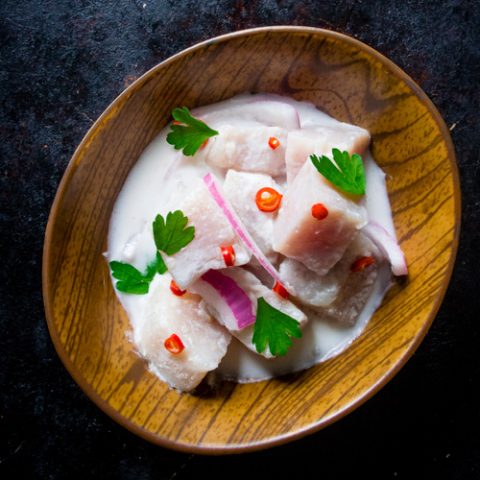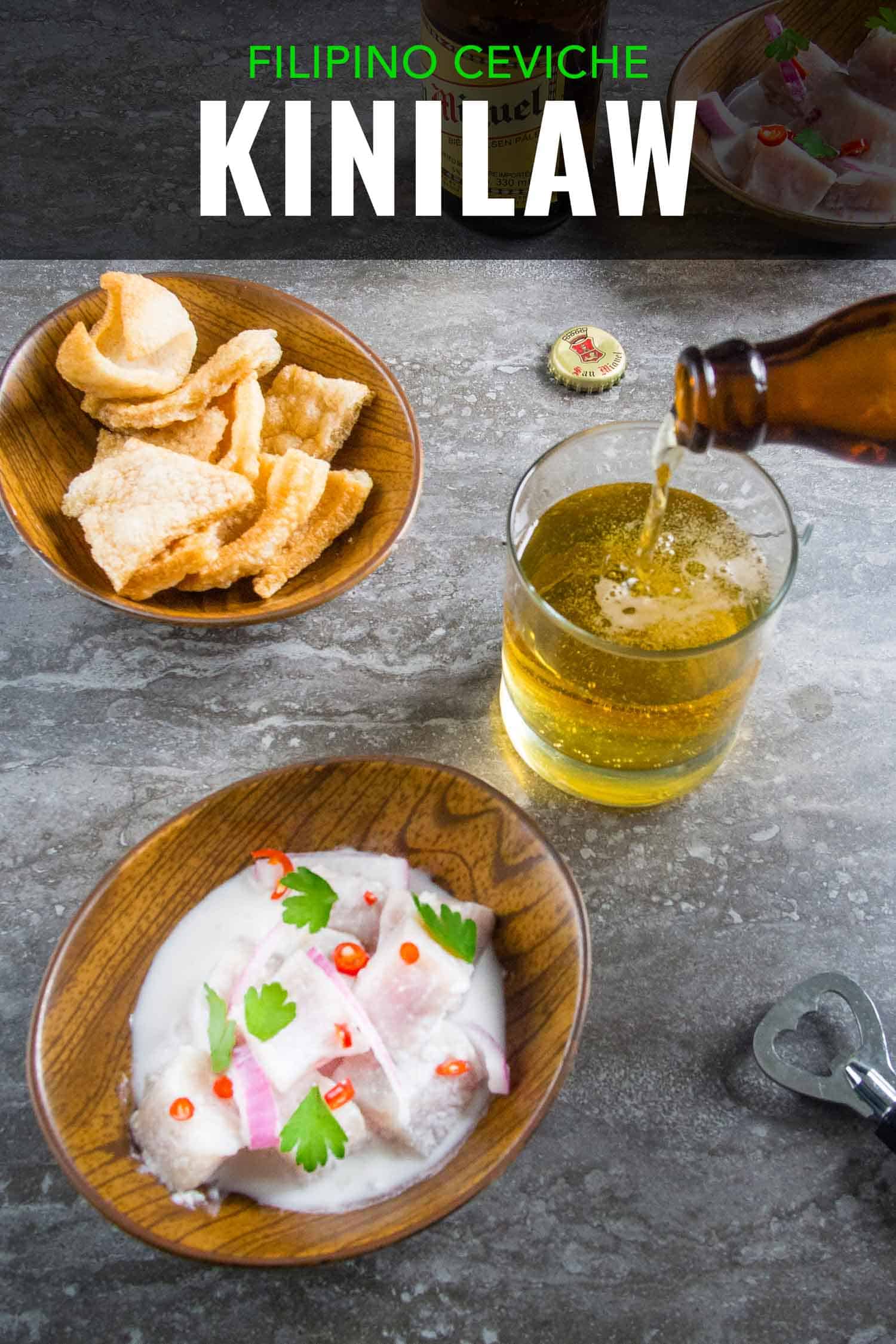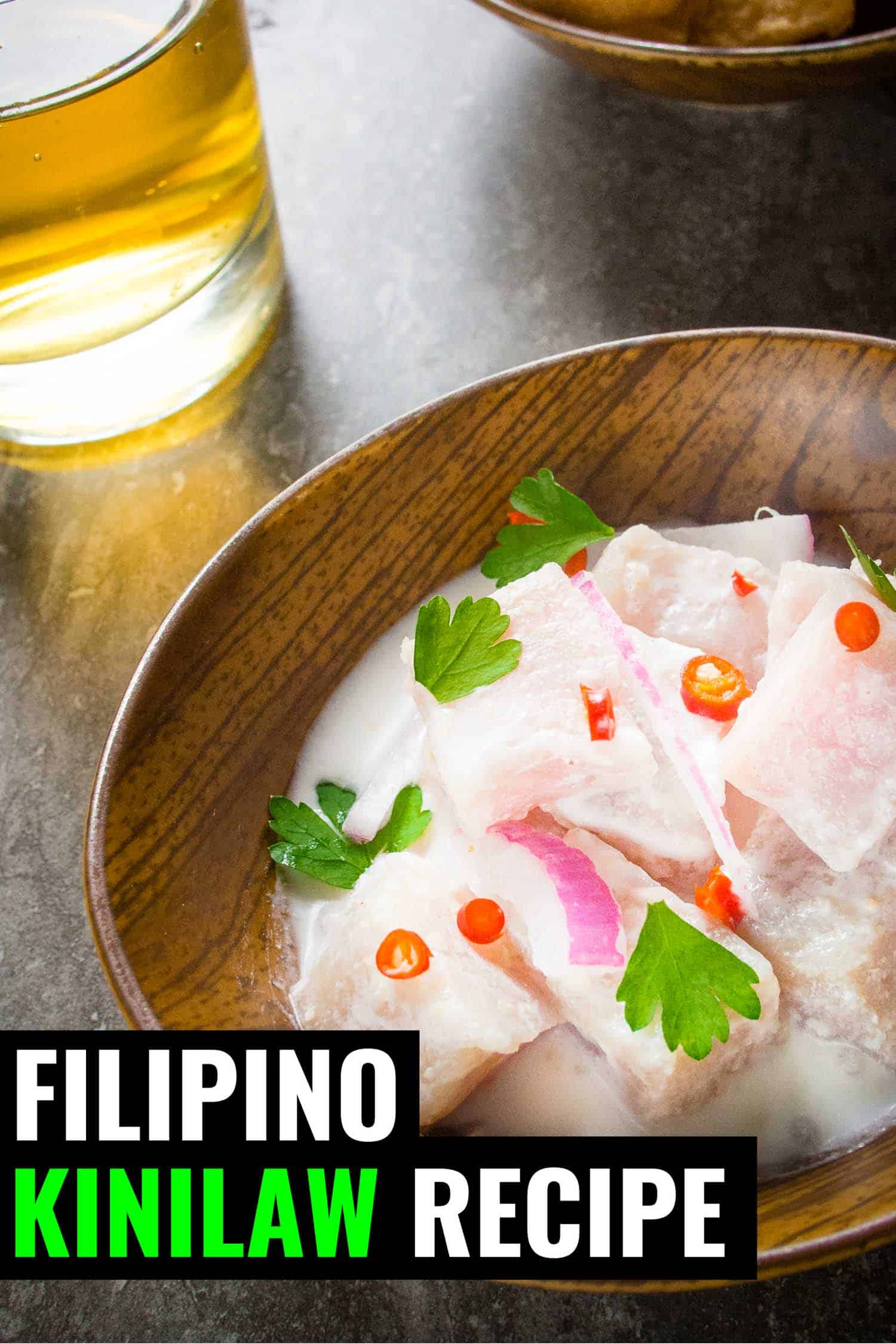This authentic Filipino kinilaw recipe is easy to make and is so much better than ceviche or poke.
I hate to frown upon the poke craze, I loved eating it in Maui and shared a recipe to make poke in five minutes.
But the poke craze went hog wild and now poke refers to anything and everything raw.
I went to a poke restaurant in Toronto and it was such a crummy version that it was time to leave poke alone.
But I love raw fish and so when Chef Crush Sheldon Simeon explained Filipino kinilaw on Top Chef I knew I had to make it.

Filipino food has a special place in my heart.
I lived in the Philippines in 1999 in Cebu for a program that helped recent graduates get international business experience overseas.
Remember that big Y2K scare?
I fled for a beach because I thought if the world was going to crumble I wanted to be somewhere beautiful.
As you can see there was nothing to worry about.
Filipino Kinilaw is not Poke but it Plays a Similar Role
In English, Kinilaw literally means “eaten raw” and while it’s often called Filipino ceviche I think it’s simplifying it a bit.
I have the same issue calling poke Hawaiian ceviche.
But like poke and ceviche it’s usually eaten before a meal as a snack or with beer – known as pulutan. Kinilaw also has a lot of the same properties you love about ceviche.
This is one of my favourite FIlipino recipes.

How is Filipino Kinilaw Different than Latin American Ceviche
If you look at this recipe for Mexican ceviche, Ecuadorian ceviche, Peruvian ceviche you’ll see one common thread – lime juice.
The acid in citrus “cooks” the seafood. Except with Ecuadorian ceviche where you cook the seafood first and then in acid.
And finally add red onion and bird’s eye chili pepper
However, the key difference in Filipino kinilaw use a different acid – vinegar.
Filipino Fruits
Both salt and vinegar are in many traditional dishes as it was a way to preserve food before refrigeration.
Tamarind and green mangos in a recipe create a sour flavour. Fresh ginger and chili peppers provide a bit of spiciness.
You can make Filipino kinilaw with any fish but it’s often made with what is available locally so it’s common to have Spanish mackerel, swordfish (warning: not always sustainable), yellowfin tuna, wahoo or anchovies.
Kinilaw isn’t just Seafood, Meet Kilawin
Generally kilawin is meat and cooked, whereas kinilaw is raw seafood.
But the terms can be interchangeable depending on where you are eating it. Kilawin exists in the northern Philippines and prepared with meat.
Unlike tartare or carpaccio, which are completely raw meat dishes it’s often quickly blanched or grilled first and served medium rare.
It’s common to have kilawin with goat, pork, beef or chicken.

But Vegetarians Can Eat Kinilaw Too!
Just like vegetarian ceviche there are also versions of kinilaw with fruits and vegetables.
Kinilaw is derived from the bisaya word kilaw which means eaten fresh, kilaw is uncooked or unripe like green mango.
Vegetarian kinilaw often has cucumber, sweet potato, banana flowers or bitter melon.
There is No One Traditional Filipino Kinilaw Recipe
The Philippines includes over 7000 islands with more than 170 languages. This means kinilaw is also known under many names including lataven and lawal.
It includes so many regional recipes from using shrimp that are still alive to raw pig heart.
I love how the variances in recipes show the cultural and geographical differences in the islands.
Where I lived in Cebu was much different than many of the islands I visited and food changed from island to island
That Said…A Traditional Filipino Kinilaw Recipe Usually Has…
Calamansi or calamondin juice which is a citrus native to the Philippines.
Calamansi looks like a key lime with a sour almost bitter flavour. If you would like to make the traditional recipe you can buy calamansi juice online.
However, lemon and lime juice are good substitutes.
Suka, aka vinegar in the Philippines. It’s most often coconut vinegar or cane vinegar, which is plentiful across the islands.
It gives kinilaw a sweet sour flavour.
If you don’t live somewhere with coconut vinegar you can mimic the flavour with white vinegar and coconut milk or coconut cream.
For this reason we have two options for the recipe: a traditional Filipino kinilaw recipe, and one that uses substitutions if you don’t have access to Filipino ingredients.

Filipino Kinilaw Recipe
This authentic Filipino kinilaw recipe is easy to make and is so much better than ceviche or poke.
Ingredients
- .5 lb firm fleshed fish
- 5 tablespoons Calamansi juice or lime juice
- 1.5 tablespoons grated ginger
- 1/4 small sliced red onion
- 3/4 cup coconut vinegar or white vinegar
- 1/3 cup coconut cream
- 3 tablespoons chopped fresh cilantro leaves for garnishing
- 4 Thai chilis, chopped
Instructions
- Cut the fillets into 1 inch cubes. Place in a bowl and season with salt and pepper.
- Add 3/4 cup vinegar and refrigerate for 10 minutes.
- Drain the vinegar gently. Return fish to the bowl.
- Add red onion, ginger, lime juice and coconut cream. Refrigerate for 30-60 minutes. The longer you marinate it the more firm the flesh will be.
- Garnish with cilantro and chili pepper. Serve with chicharron.
Recommended Products
Nutrition Information:
Yield: 4 Serving Size: 1 Amount Per Serving: Calories: 253Total Fat: 10gSaturated Fat: 9gTrans Fat: 0gUnsaturated Fat: 1gCholesterol: 32mgSodium: 99mgCarbohydrates: 26gFiber: 2gSugar: 21gProtein: 16gNutritional information is provided as a courtesy and is an estimate only. This information comes from online calculators. Although BaconisMagic.ca attempts to provide accurate nutritional information, these figures are only estimates.
Pin it For Later: Kinilaw Na Tuna







I will try this recipe in my next party . it look like so tasty…..
I’ve never come across this before but really enjoyed learning about it. I agree that the poke craze seems to be a bit OTT, especially when I’d just as happily have a Japanese chirashi don! But I also enjoy ceviche and love seeing how different cultures have arrived at not entirely disimilar dishes. I have only had limited exposure to Filipino food, attending some pop up events here in London, and am keen to try more!
Not only is the intro to Kinilaw, unknow before I read this, sound awesome, I have a bunch of new ingredients I havenever heard of either to hopefull source…but thakns for the alternatives. Only had poke once but it was Meh so have not hopped on the big craze.
I remember eating poke in Las Vegas before poke became a “thing” and jumped the shark. Now I want to try kinilaw.
Okay, now I’m hungry. Bookmarked this post. thanks a lot! 🙂
Looks like mouthwatering , Filipino Kinilaw will be my next recipe….
We do this a lot! For fish we usually use milkfish, tilapia or tuna. It’s really good and it matches well with beer. 🙂
I’ve never heard of this dish or coconut vinegar before but it looks and sound amazing. Will bookmark this to make when I get all the ingredients. I will have to search for coconut vinegar because that sounds awesome. I’m not sure if they have that here in Ontario though.
Love love love Filipino food! All sorts of pulutan with San Mig Dry and I’m done for the day. I couldn’t have explained kinilaw better myself 🙂
This is my personal favorite and I would like to share that you can do a lot of variations to it. You can try it with peanut, salted egg and/or mayonnaise. This is best served with grilled pork seasoned with salt and pepper only.
I can imagine the beach while enjoying this. A must-try for everyone.
I love kinilaw! I make it but without the coconut cream. What brand of coconut cream you use?
I use Grace Foods but I think you could use any reputable brand.
Had Kinilaw while island hopping with family outside of Cebu. My relatives packed a picnic to take with us to the tiny island for a snorkeling day trip and brought a dish I’d never heard of before, kinilaw. It was the best version of a ‘ceviche-like’ dish I ever had— fat chunks of raw white fish with coconut, vinegar and red onion . Still one of the best culinary experiences of my life.
I think its the coconut milk, it makes it so much better.
I just got back from the vicinity of CDO. I was looking to bring back this to my friends. Your cultural knowledge on the dish is very good.
The people who prepared it for me also used chopped ginger.
Very cool, ginger would be a great addition.
I tried making this for the 1st time. I made a mistake though. I followed the 1st instruction with soaking the fish bits (precut and prepacked basa and salmon fishes) for exactly 10 mins in the fridge. Which didn’t completely soak all the fish bits. Leaving the others completely raw and uncooked by the vinegar. Should have checked them all before draining all vinegar. Using regular white vinegar I could get my hands on where I am and
I used lime juice instead of calamansi as substitute because they’re not available where I am. I used regular home grown chillies sold by an asian grocer.
As well as pepper and salt. As for coconut cream? I used a thai brand and made one bought from an asian shop.
How much quantity of lime? Ginger? Red onion? Coconut cream do you put?
Wow! Sept. of 1999 was the year I 1st went back to my birth and old home town of cebu. Since immigrating to foreign country. Direct flight from place of departure to Kuala Lumpur to Cebu.
You’re from Cebu, that’s awesome! I actually have a friend who is trying to get me to come back this year.
As for the recipe…As long as your fish has been coated they will continue to be “cooked” by the acid as it’s not rinsed off.
The quantity of all of the ingredients is included in the recipe.
Yeah from Cebu.
I’m trying to remake it again now actually. Fish bits were just placed in vinegar in the fridge now. I’m using the same available ingredients I can get my hands on where I am.
I remember a filipino gathering when family members would make kinilaw. In another way of making it. I also remember eating kinilaw by the beach in cebu back in 2005. It was bought from a vendor. So I don’t know how it was exactly made but I do remember cream was used. I remember 1 person’s way of making it and it was left immersed in the vinegar along with the other ingredients. Until it’s fully eaten off. It contained other vegies like cucumber, tomatoes, as well as other types of vegies I can’t recall precisely. They had added out of spontaneous desire.
No one’s taught me cooking filipino food. I’m try this way of making kinilaw this way.
Fingers crossed. Hopefully this times I’m going to enjoy it.
I had kokoda in Fiji and it’s made with a cream. Have a look at this post, maybe it’s similar?
https://www.thisislandlife.com/travel/how-to-make-kokoda-recipe/
Thanks again. Hope to see your next recipe if you do go back to cebu.
My second attempt wasn’t too bad. But because I left it a bit too long soaking in the vinegar. It had a rather strong vinegar taste. Anyway I hope the third attempt is a taste from heaven. If I can. I will try your fijian recipe..
Oh yeah. How stupid of me to asks the quantity of all and each ingredients. It shows. Duh! HaHa.
I watched my Filipina wife make kinilaw on my first visit, before we were wed. I thought it was a bit insane, but wanted to taste it. She made me wait until we got to the beach. I now realize why. It needs to marinate. It is one of the most wonderful things I have ever eaten, and I was a chef.
Oh you should try the kinilaw in Mindanao, the southern part of the Philippines. l’d say it has the best version or versions of it. This recipe you’ve shared must be from Visayas. Cebu and Negros uses the coconut milk. Another great addition in Visayas’ version is ground chicharon or pork crackling. Heavenly.
But Mindanao kinilaw is perhaps the most authentic of all, the closest to the original. It uses the day old coconut wine or tuba. This is perhaps the most critical of all ingredients. This is used for the dressing that’s mixed with onion, lemoncito, ginger and local chili.
The raw fish is washed by a day-old tuba or what we call bahal. Washed means you pour on the fish flesh and remove it as quickly. This will ‘acid sear’ the fish but keep the rawness intact. In the northern and western parts of Mindanao, this bahal is mixed with tabon-tabon to balance the fishiness. Then there’s the local lime or biasong. In general, the versions found in Mindanao vary as to the acidity , dressing consistency and volume and the ingredients added on top of the mainstays-tuba, lemonsito, ginger, chili and onion.
So now we combine the washed fish, the dressing with spices and salt just before you serve. Normally slices of cucumber and radish are added. There is no time to waste once you’ve mixed everything. I personally think that after 30 minutes, the kinilaw loses all of its gastronomic glory.
The kinilaw is a dish that’s revered by Filipinos. It is like lechon, you can’t have a real party or gathering if these are not served.
Yes I live in Cebu in 1999! I am hoping to get back to the Philippines this year now that it has opened up to tourists.
Yes, and when you do, I hope you can try the kinilaw in our part of the world, Mindanao. By the way, Luzon’s kinilaw, which they call kilawin, is sadly forgettable.